|
|
|
Sort Order |
|
|
|
Items / Page
|
|
|
|
|
|
|
| Srl | Item |
| 1 |
ID:
187062
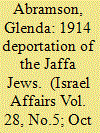

|
|
|
|
|
| Summary/Abstract |
Ahmed Djemal Pasha, Military Governor of the Levant during World War I, instigated two major deportations of Jews from Jaffa during the course of the war, and numerous lesser ones. On 17 December 1914, a day that came to be known as ‘Black Thursday’, the Ottoman ruler of Jaffa, under Djemal’s command, ordered the mass deportation of ‘enemy subjects’, including 6,000 Russian-born Jewish residents of Jaffa. Over the course of the next three months, a few thousand more Russian-born Jews were expelled from Palestine or fled just ahead of the deportations. In total 11,277 Jews were exiled, leaving on various ships that took them from Jaffa to Alexandria. This article describes the ‘Black Thursday’ deportation based on testimonies of those who either witnessed it or were its victims, and briefly on the two works of documentary fiction that provide a rounded context for the many accounts.
|
|
|
|
|
|
|
|
|
|
|
|
|
|
|
|
| 2 |
ID:
115335
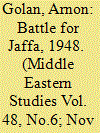

|
|
|
|
|
| Publication |
2012.
|
| Summary/Abstract |
Modern armies conduct military operations in urban areas, but rarely do so willingly. Military commanders prefer fighting in open terrain in which forces freely maneuver and use firepower, rather than in urban areas in which obstacles such as tall buildings, narrow streets, and non-combatants hinder control of the battlefield. Most professional military literature recommends refraining from fighting in urban areas and considering urban battles an unfortunate aberration to be avoided in the future. Deliberate choice of an urban battlefield is quite exceptional, deriving mostly from strategic needs or due to the symbolic value ascribed to a particular city or town. Most decisive battles of the first Arab-Israeli war in 1948 were fought in open areas. However, strategic and political considerations, as well as cultural and sentimental, caused both sides to fight in cities and towns, such as in the case of Jaffa and Tel Aviv metropolitan area, Palestine's major economic center and a main road junction. Both cities also held sentimental value: the dynamically developing modern Jaffa was a symbol of an emerging Palestinian nation while Tel Aviv, the "first Hebrew city," was the Zionist ideal of urban development.
|
|
|
|
|
|
|
|
|
|
|
|
|
|
|
|
| 3 |
ID:
092915
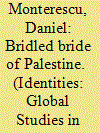

|
|
|
|
|
| Publication |
2009.
|
| Summary/Abstract |
Through ethnographic and archival research centered in Jaffa, this article analyzes how the image of the Jewish-Arab mixed city has been represented and (re)produced in the Zionist historical imagination since the establishment of the state of Israel to the present. Vacillating between romantic historicity and political violence, the image of Jaffa poses a political and hermeneutic challenge to the territorial project of urban Judaization, which ultimately failed to define and establish the national-cum-cultural identity of this "New-Old" city. This failure, I argue, results in a persistent pattern of semiotic ambivalence which, from the Jewish-Israeli point of view, positions Jaffa both as a source of identity and longing (in the distant past) as well as a symbol of alterity and enmity (in the recent past)- an object of desire and fear alike. As such, Jaffa and other ethnically mixed towns (including Ramle, Lydda, Haifa, and Acre) occupy a problematic place in Israeli and Palestinian political and cultural imagination. A bi-national borderland in which Arabs and Jews live de facto together, these cities bring to the fore, on the one hand, the paradox of Palestinian citizens in a fundamentally Jewish state, while simultaneously suggesting, by the very spatial and social realization of "mixed-ness," the potential imaginary of its solution. Unfolding through four distinct historical modalities of urban Orientalism, this article historicizes the highly politicized image of the Jewish-Arab city and the discourse on its future. These discursive formations reconfigured the public space that enabled, paradoxically since the October 2000 events, new political claims for equal citizenship, bi-national cooperation, and Palestinian presence.
|
|
|
|
|
|
|
|
|
|
|
|
|
|
|
|
| 4 |
ID:
168373
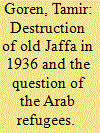

|
|
|
|
|
| Summary/Abstract |
One outcome of the Jewish–Arab conflict at the time of the British Mandate was the Arab refugee problem. It usually accompanied any escalation in hostilities and was evident at foci of the friction between Arabs and Jews. Reprisals by the authorities against the Arab population was an additional cause. At the time of the Arab Revolt the refugee issue assumed for the first time significant proportions as a result of destructive actions by the British army, the greatest being the home demolition operations unleashed in Jaffa. As a result many families became refugees inside and outside their city. For the first time in the Mandate period the British government was obliged to contend with the problem of Arab refugees that it itself had created, and resolve it. The article aims to shed light on a unique operation by the Mandatory government intended to establish a locality to house Arab refugees, which was implemented and completed in the Mandate period. The article shows that for the authorities the establishment of a quarter for refugees was the required and most appropriate solution to the problem that had arisen.
|
|
|
|
|
|
|
|
|
|
|
|
|
|
|
|
| 5 |
ID:
143624
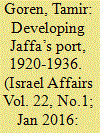

|
|
|
|
|
| Summary/Abstract |
Jaffa port was long renowned as the main harbour of Palestine. From the onset of the British Mandate intense activity in turning it into a modern port resulted in the appointment of a series of committees composed of Arab and Jewish representatives from Jaffa and Tel Aviv. From the start, it was clearly in Tel Aviv’s interest to work for the development of Jaffa port, although the city did not concede its own desire to establish a port of its own; thus the developments taking place at Jaffa port carried implications for Tel Aviv in determining its moves. This article sheds light for the first time on the joint conduct of Jaffa and Tel Aviv regarding the development of the port at Jaffa, and examines its implications. It shows that both cities operated in a considered way before the authorities, and benefited the Jaffa port project, but at the same time Tel Aviv’s ambition for a port of its own was fostered.
|
|
|
|
|
|
|
|
|
|
|
|
|
|
|
|
| 6 |
ID:
177272
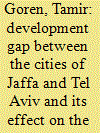

|
|
|
|
|
| Summary/Abstract |
At the time of the British Mandate in Palestine the development of Tel Aviv, which the Jaffa Arabs regarded as the realization of the Zionist enterprise, was perceived as a real threat to Jaffa’s future. The two cities’ geographic proximity threw into bold relief the differences between the two levels of development. As the years passed the two cities’ development demonstrated Tel Aviv’s supremacy over Jaffa. From the years of the Arab revolt (1936-1939) the gap between the development of Tel Aviv and of Jaffa inexorably widened. By time the Mandate ended Jaffa’s condition had so deteriorated that the need to narrow the gap had become urgent. Jaffa had to be transformed into a modern city, but also – indeed principally – to be restored to its former strength and status in the context of the worsening Arab-Jewish conflict. The will to achieve this aim intensified as long as Tel Aviv continued to flourish. The article evaluates how far the chasm between the two cities in their development influenced Jaffa’s condition in the declining years of the Mandate. It shows that it damaged Jaffa, being a significant factor reducing its status as an urban center.
|
|
|
|
|
|
|
|
|
|
|
|
|
|
|
|
| 7 |
ID:
148625
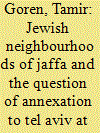

|
|
|
|
|
| Summary/Abstract |
One of the most complex issues facing British rule on the local municipal level towards the end of the Mandate period was the problem of Jaffa's Jewish neighbourhoods. This question, which emerged with the outbreak of the 1936 disturbances, engaged the government thereafter until the end of the Mandate. The demand by the residents of Jaffa's Jewish neighbourhoods for annexation to Tel Aviv – actually for municipal detachment from Jaffa – constituted the root of the problem. In this setting of the sharpening of relations between the authorities and the Jews and Arabs in 1945–1947, all three involved parties found themselves deeply immersed in it in the attempt to bring about its resolution. The annexation problem ceaselessly preoccupied the institutions of the Jewish Yishuv as a Zionist–Yishuv struggle of the highest order. This period gave rise to a series of unprecedented moves by the Jewish side, which were intended to influence the British government toward solving the problem. The article examines its development of the problem from the viewpoint of the three sides concerned in the years 1945–1947, with the focus on the policy line adopted by the Jewish side, its implications and its results.
|
|
|
|
|
|
|
|
|
|
|
|
|
|
|
|
| 8 |
ID:
158069
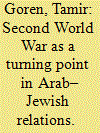

|
|
|
|
|
| Summary/Abstract |
One of the gravest outcomes of the period of the Arab revolt was the heavy economic damage caused to the Arab community. Jaffa, which suffered greatly in the years 1936–1939, sought to rebuild and restore the city to its status as a leading economic center in Palestine. This need intensified still more with the outbreak of the Second World War. Hence, it was in Jaffa's evident interest to bring about an improvement in relations with Tel Aviv and with Jews generally. Problems regarding the proper management of economic life in wartime exercised the Jewish settlement also; therefore, Jewish–Arab cooperation steadily grew in this period. The article gauges the measure of this cooperation and the nature of the ties that consolidated between Arabs and Jews during the war. The situation of Jaffa and Tel Aviv serves as a test case well exemplifying the force of the subsequent change in relations between Jews and Arabs in Palestine.
|
|
|
|
|
|
|
|
|
|
|
|
|
|
|
|
| 9 |
ID:
146790
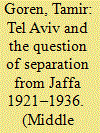

|
|
|
|
|
| Summary/Abstract |
The ordinance granting Tel Aviv the status of local council was given in 1921. Immediately thereafter, the municipal council acted to amend the terms of the ordinance so as to free Tel Aviv entirely from the supervision of Jaffa municipality. Tel Aviv aimed for the status of an independent municipality, but still wished to safeguard its interests in Jaffa. Detachment from Jaffa was for long a central issue for Tel Aviv municipality. The article analyses the Jewish side's stance on Jaffa from 1921 until the outbreak of the disturbances in 1936, when Tel Aviv detached itself almost entirely from Jaffa. In the 1920s, the importance of Jaffa for the Jews was mainly economic, but in the 1930s, the addition of the demographic dimension reflected the growing status of the Jaffa Jewish community and was decisive in increasing the Jewish influence in Jaffa.
|
|
|
|
|
|
|
|
|
|
|
|
|
|
|
|
|
|
|
|
|